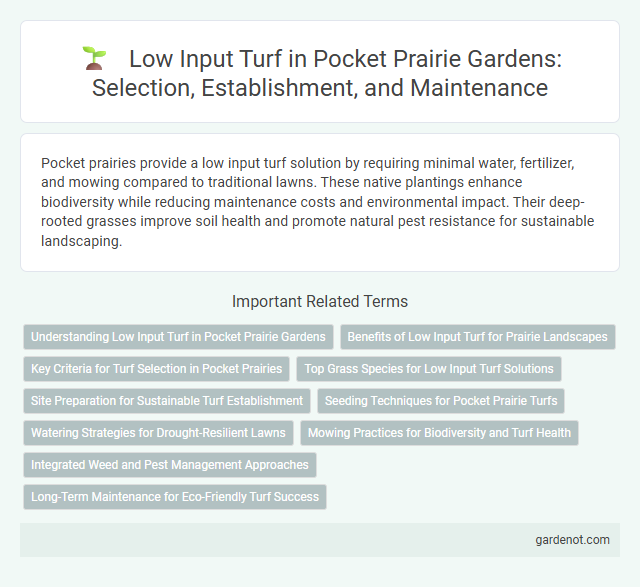Pocket prairies provide a low input turf solution by requiring minimal water, fertilizer, and mowing compared to traditional lawns. These native plantings enhance biodiversity while reducing maintenance costs and environmental impact. Their deep-rooted grasses improve soil health and promote natural pest resistance for sustainable landscaping.
Understanding Low Input Turf in Pocket Prairie Gardens
Low input turf in pocket prairie gardens emphasizes native grasses and plants adapted to local soil and climate conditions, reducing the need for fertilizers and irrigation. Embracing species such as buffalo grass and blue grama enhances biodiversity while minimizing maintenance demands. This approach supports sustainable landscaping by promoting soil health and conserving water resources.
Benefits of Low Input Turf for Prairie Landscapes
Low input turf in prairie landscapes significantly reduces water usage and maintenance costs, promoting sustainability by requiring minimal irrigation and fertilizer application. This turf supports biodiversity by providing habitat for native pollinators and wildlife while enhancing soil health through deep-rooted grasses that prevent erosion. Its resilience to drought and pests ensures long-term aesthetic appeal and ecosystem stability with fewer chemical inputs.
Key Criteria for Turf Selection in Pocket Prairies
Key criteria for turf selection in pocket prairies include drought tolerance, low maintenance requirements, and native species compatibility. Selecting turf varieties like fine fescues or buffalo grass supports biodiversity while reducing water and fertilizer inputs. Emphasizing deep root systems enhances soil health and resilience to urban stressors.
Top Grass Species for Low Input Turf Solutions
Top grass species for low input turf solutions include fine fescues, buffalo grass, and Kentucky bluegrass, known for their drought tolerance and minimal fertilization needs. Fine fescues such as creeping red fescue and chewings fescue thrive in shaded areas and require less water, making them ideal for sustainable pocket prairies. Buffalo grass excels in hot, dry climates with low maintenance, while Kentucky bluegrass offers durability and moderate drought resistance for versatile low input turf establishment.
Site Preparation for Sustainable Turf Establishment
Effective site preparation for low input turf in pocket prairies involves thorough soil assessment and organic matter incorporation to enhance nutrient retention and water infiltration. Minimizing soil disturbance preserves native microbial communities essential for sustainable turf establishment and resilience against pests. Selecting drought-tolerant native grass species adapted to local climate conditions reduces maintenance requirements and supports ecological balance.
Seeding Techniques for Pocket Prairie Turfs
Seeding techniques for pocket prairie turfs emphasize low input turf management by selecting native, drought-tolerant species that require minimal water and fertilizer. Precision seeding methods, such as calibrated seed drills or broadcast seeding with tailored seed mixes, optimize establishment and biodiversity. Proper timing during early spring or fall maximizes seed germination rates and long-term turf resilience.
Watering Strategies for Drought-Resilient Lawns
Low input turf in pocket prairies thrives with strategic watering methods that promote deep root growth while conserving water. Employ techniques like infrequent, deep watering early in the morning to minimize evaporation and encourage drought resilience. Selecting native grass species with high drought tolerance further reduces irrigation needs, ensuring sustainable lawn maintenance.
Mowing Practices for Biodiversity and Turf Health
Low input turf in pocket prairie landscapes thrives with reduced mowing frequency, promoting biodiversity by allowing native plants and pollinators to flourish. Strategic mowing height, typically maintained at 4-6 inches, supports deep root growth and enhances turf resilience against pests and drought. Applying seasonal mowing regimes aligns with natural growth cycles, ensuring strong turf health and minimizing ecological disruption.
Integrated Weed and Pest Management Approaches
Low input turf in pocket prairies relies on Integrated Weed and Pest Management (IWPM) strategies that combine biological controls, selective herbicides, and timely mowing to maintain plant health and biodiversity. Emphasizing native species resilience reduces chemical dependence while promoting soil health and minimizing invasive weed establishment. Monitoring pest populations and using habitat diversification further support sustainable turf management with reduced environmental impact.
Long-Term Maintenance for Eco-Friendly Turf Success
Low input turf requires minimal watering, fertilization, and mowing, significantly reducing environmental impact while promoting biodiversity in pocket prairies. Long-term maintenance focuses on using native grasses and hardy plants adapted to local conditions, enhancing soil health and resilience against pests and diseases. Sustainable practices like periodic overseeding and organic mulch application support eco-friendly turf success by maintaining vibrant growth and ecological balance.
Low input turf Infographic

 gardenot.com
gardenot.com